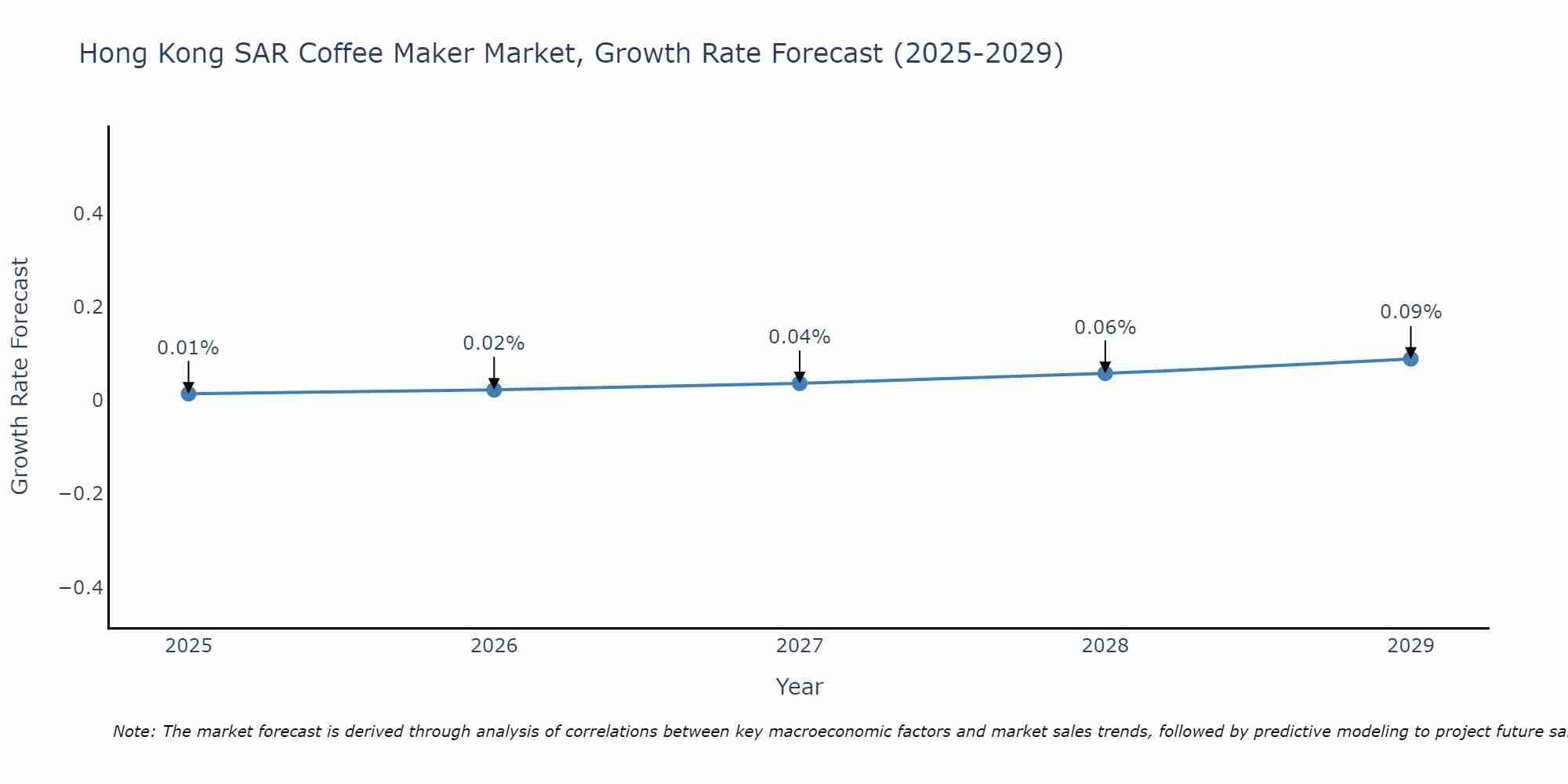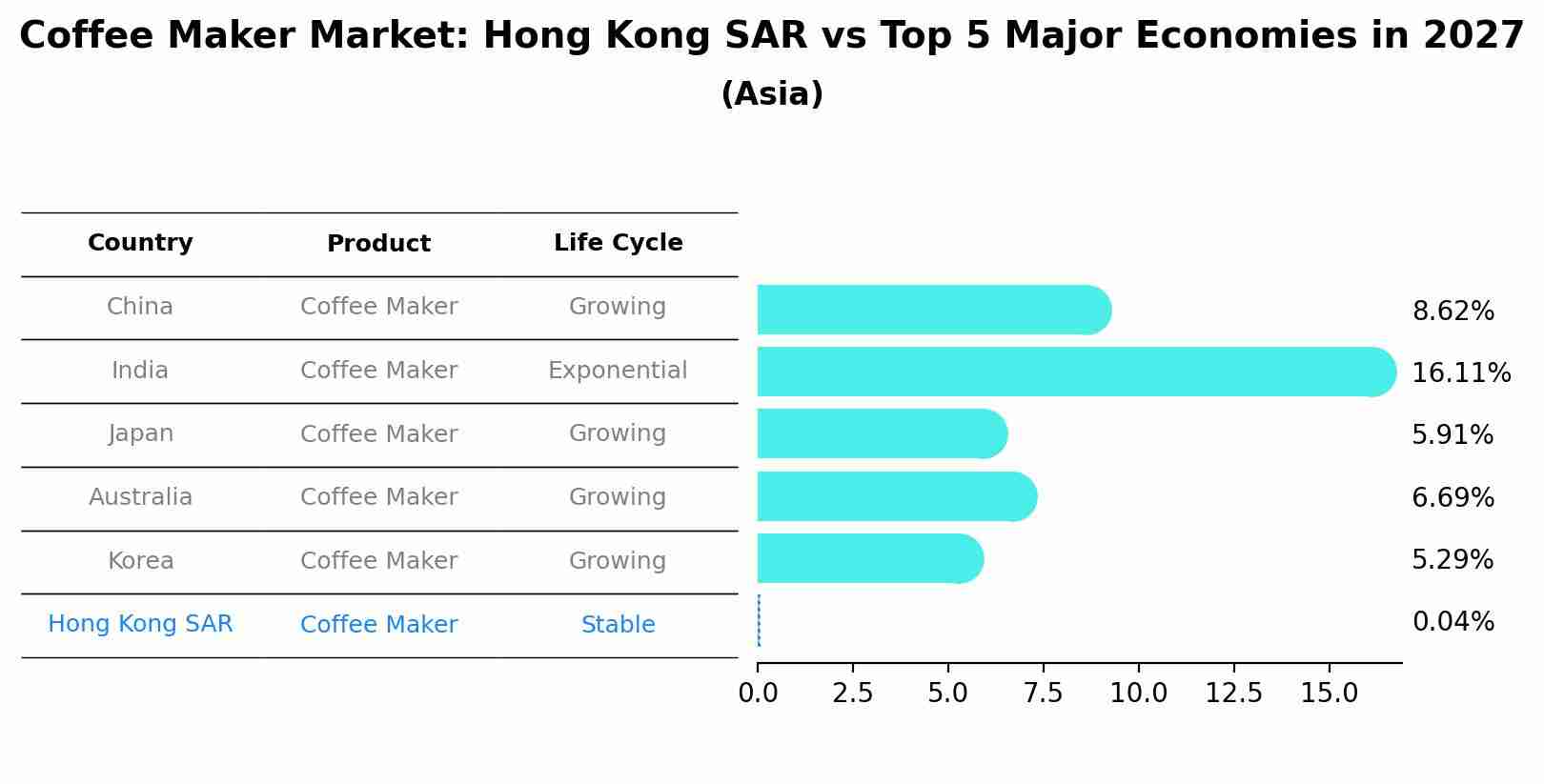Hong Kong Coffee Maker Market (2025-2031) | Companies, Revenue, Size, Outlook, Analysis, Segmentation, Industry, Trends, Share, Growth, Forecast & Value
| Product Code: ETC4798019 | Publication Date: Nov 2023 | Updated Date: Apr 2025 | Product Type: Market Research Report | |
| Publisher: 6Wresearch | Author: Sachin Kumar Rai | No. of Pages: 60 | No. of Figures: 30 | No. of Tables: 5 |
Hong Kong SAR Coffee Maker Market Size Growth Rate
The Hong Kong SAR Coffee Maker Market is poised for steady growth rate improvements from 2025 to 2029. From 0.01% in 2025, the growth rate steadily ascends to 0.09% in 2029.

Coffee Maker Market: Hong Kong SAR vs Top 5 Major Economies in 2027 (Asia)
By 2027, Hong Kong SAR's Coffee Maker market is forecasted to achieve a stable growth rate of 0.04%, with China leading the Asia region, followed by India, Japan, Australia and South Korea.

Hong Kong Coffee Maker Market Synopsis
The coffee maker market in Hong Kong is expanding as consumers seek convenient and efficient brewing solutions for their coffee needs. This market encompasses various types of coffee makers, including drip machines, espresso machines, and single-serve systems. The demand for coffee makers is driven by the increasing popularity of home brewing and the desire for quality coffee experiences. As manufacturers focus on innovation and user-friendly designs, the adoption of advanced coffee makers is expected to rise, transforming the coffee experience for consumers.
Drivers of the market
The coffee maker market in Hong Kong is fueled by the growing coffee culture, both in commercial establishments and at home. The increasing preference for specialty coffee and convenience has driven demand for various types of coffee makers, from automatic drip machines to espresso makers. The rise in disposable income and urbanization also supports the market`s expansion.
Challenges of the market
The coffee maker market in Hong Kong encounters challenges linked to technological innovation and changing consumer lifestyles. Rapid advancements in coffee brewing technology necessitate that manufacturers stay ahead of trends to meet consumer demands for convenience and quality. As consumers increasingly prioritize specialty coffee experiences at home, the market is witnessing a rise in demand for high-end coffee machines, putting pressure on producers to offer unique features and superior performance. However, this demand for innovation can strain production capabilities and require significant investment in research and development. Additionally, the COVID-19 pandemic has altered consumer behaviors, with more people working from home, leading to increased competition among brands to capture market share. Companies must navigate these challenges by focusing on product differentiation, enhancing customer experiences, and leveraging online marketing strategies to engage consumers effectively.
Government Policy of the market
In the Coffee Maker market, the Hong Kong government emphasizes policies that ensure compliance with safety and quality standards for coffee-making appliances. Regulations are established to ensure that coffee makers meet energy efficiency standards. The government promotes research into innovative coffee-making technologies that enhance user experience and product performance. Additionally, initiatives are aimed at supporting training programs for technicians in coffee maker maintenance and repair.
Key Highlights of the Report:
- Hong Kong Coffee Maker Market Outlook
- Market Size of Hong Kong Coffee Maker Market, 2024
- Forecast of Hong Kong Coffee Maker Market, 2031
- Historical Data and Forecast of Hong Kong Coffee Maker Revenues & Volume for the Period 2021-2031
- Hong Kong Coffee Maker Market Trend Evolution
- Hong Kong Coffee Maker Market Drivers and Challenges
- Hong Kong Coffee Maker Price Trends
- Hong Kong Coffee Maker Porter`s Five Forces
- Hong Kong Coffee Maker Industry Life Cycle
- Historical Data and Forecast of Hong Kong Coffee Maker Market Revenues & Volume By Types for the Period 2021-2031
- Historical Data and Forecast of Hong Kong Coffee Maker Market Revenues & Volume By Drip Coffee Machine for the Period 2021-2031
- Historical Data and Forecast of Hong Kong Coffee Maker Market Revenues & Volume By Steam Coffee Machine for the Period 2021-2031
- Historical Data and Forecast of Hong Kong Coffee Maker Market Revenues & Volume By Capsule Coffee Machine for the Period 2021-2031
- Historical Data and Forecast of Hong Kong Coffee Maker Market Revenues & Volume By Others for the Period 2021-2031
- Historical Data and Forecast of Hong Kong Coffee Maker Market Revenues & Volume By End-users for the Period 2021-2031
- Historical Data and Forecast of Hong Kong Coffee Maker Market Revenues & Volume By Commercial for the Period 2021-2031
- Historical Data and Forecast of Hong Kong Coffee Maker Market Revenues & Volume By Industrial for the Period 2021-2031
- Historical Data and Forecast of Hong Kong Coffee Maker Market Revenues & Volume By Distribution Channel for the Period 2021-2031
- Historical Data and Forecast of Hong Kong Coffee Maker Market Revenues & Volume By Online for the Period 2021-2031
- Historical Data and Forecast of Hong Kong Coffee Maker Market Revenues & Volume By Offline for the Period 2021-2031
- Hong Kong Coffee Maker Import Export Trade Statistics
- Market Opportunity Assessment By Types
- Market Opportunity Assessment By End-users
- Market Opportunity Assessment By Distribution Channel
- Hong Kong Coffee Maker Top Companies Market Share
- Hong Kong Coffee Maker Competitive Benchmarking By Technical and Operational Parameters
- Hong Kong Coffee Maker Company Profiles
- Hong Kong Coffee Maker Key Strategic Recommendations
Frequently Asked Questions About the Market Study (FAQs):
1 Executive Summary |
2 Introduction |
2.1 Key Highlights of the Report |
2.2 Report Description |
2.3 Market Scope & Segmentation |
2.4 Research Methodology |
2.5 Assumptions |
3 Hong Kong Coffee Maker Market Overview |
3.1 Hong Kong Country Macro Economic Indicators |
3.2 Hong Kong Coffee Maker Market Revenues & Volume, 2021 & 2031F |
3.3 Hong Kong Coffee Maker Market - Industry Life Cycle |
3.4 Hong Kong Coffee Maker Market - Porter's Five Forces |
3.5 Hong Kong Coffee Maker Market Revenues & Volume Share Segmentations, 2021 & 2031F |
3.6 Hong Kong Coffee Maker Market Revenues & Volume Share, By End-users, 2021 & 2031F |
3.7 Hong Kong Coffee Maker Market Revenues & Volume Share, By Distribution Channel, 2021 & 2031F |
4 Hong Kong Coffee Maker Market Dynamics |
4.1 Impact Analysis |
4.2 Market Drivers |
4.3 Market Restraints |
5 Hong Kong Coffee Maker Market Trends |
6 Hong Kong Coffee Maker Market Segmentations |
6.1 Hong Kong Coffee Maker Market Segmentations |
6.1.1 Overview and Analysis |
6.1.2 Hong Kong Coffee Maker Market Revenues & Volume, By Drip Coffee Machine, 2021-2031F |
6.1.3 Hong Kong Coffee Maker Market Revenues & Volume, By Steam Coffee Machine, 2021-2031F |
6.1.4 Hong Kong Coffee Maker Market Revenues & Volume, By Capsule Coffee Machine, 2021-2031F |
6.1.5 Hong Kong Coffee Maker Market Revenues & Volume, By Others, 2021-2031F |
6.2 Hong Kong Coffee Maker Market, By End-users |
6.2.1 Overview and Analysis |
6.2.2 Hong Kong Coffee Maker Market Revenues & Volume, By Commercial, 2021-2031F |
6.2.3 Hong Kong Coffee Maker Market Revenues & Volume, By Industrial, 2021-2031F |
6.3 Hong Kong Coffee Maker Market, By Distribution Channel |
6.3.1 Overview and Analysis |
6.3.2 Hong Kong Coffee Maker Market Revenues & Volume, By Online, 2021-2031F |
6.3.3 Hong Kong Coffee Maker Market Revenues & Volume, By Offline, 2021-2031F |
7 Hong Kong Coffee Maker Market Import-Export Trade Statistics |
7.1 Hong Kong Coffee Maker Market Export to Major Countries |
7.2 Hong Kong Coffee Maker Market Imports from Major Countries |
8 Hong Kong Coffee Maker Market Key Performance Indicators |
9 Hong Kong Coffee Maker Market - Opportunity Assessment |
9.1 Hong Kong Coffee Maker Market Opportunity Assessment Segmentations, 2021 & 2031F |
9.2 Hong Kong Coffee Maker Market Opportunity Assessment, By End-users, 2021 & 2031F |
9.3 Hong Kong Coffee Maker Market Opportunity Assessment, By Distribution Channel, 2021 & 2031F |
10 Hong Kong Coffee Maker Market - Competitive Landscape |
10.1 Hong Kong Coffee Maker Market Revenue Share, By Companies, 2024 |
10.2 Hong Kong Coffee Maker Market Competitive Benchmarking, By Operating and Technical Parameters |
11 Company Profiles |
12 Recommendations | 13 Disclaimer |
- Single User License$ 1,995
- Department License$ 2,400
- Site License$ 3,120
- Global License$ 3,795
Search
Related Reports
- Middle East OLED Market (2025-2031) | Outlook, Forecast, Revenue, Growth, Companies, Analysis, Industry, Share, Trends, Value & Size
- Taiwan Electric Truck Market (2025-2031) | Outlook, Industry, Revenue, Size, Forecast, Growth, Analysis, Share, Companies, Value & Trends
- South Korea Electric Bus Market (2025-2031) | Outlook, Industry, Companies, Analysis, Size, Revenue, Value, Forecast, Trends, Growth & Share
- Vietnam Electric Vehicle Charging Infrastructure Market (2025-2031) | Outlook, Analysis, Forecast, Trends, Growth, Share, Industry, Companies, Size, Value & Revenue
- Vietnam Meat Market (2025-2031) | Companies, Industry, Forecast, Value, Trends, Analysis, Share, Growth, Revenue, Size & Outlook
- Vietnam Spices Market (2025-2031) | Companies, Revenue, Share, Value, Growth, Trends, Industry, Forecast, Outlook, Size & Analysis
- Iran Portable Fire Extinguisher Market (2025-2031) | Value, Forecast, Companies, Industry, Analysis, Trends, Growth, Revenue, Size & Share
- Philippines Animal Feed Market (2025-2031) | Companies, industry, Size, Share, Revenue, Analysis, Forecast, Growth, Outlook
- India Lingerie Market (2025-2031) | Companies, Growth, Forecast, Outlook, Size, Value, Revenue, Share, Trends, Analysis & Industry
- India Smoke Detector Market (2025-2031) | Trends, Share, Analysis, Revenue, Companies, Industry, Forecast, Size, Growth & Value
Industry Events and Analyst Meet
Our Clients
Whitepaper
- Middle East & Africa Commercial Security Market Click here to view more.
- Middle East & Africa Fire Safety Systems & Equipment Market Click here to view more.
- GCC Drone Market Click here to view more.
- Middle East Lighting Fixture Market Click here to view more.
- GCC Physical & Perimeter Security Market Click here to view more.
6WResearch In News
- Doha a strategic location for EV manufacturing hub: IPA Qatar
- Demand for luxury TVs surging in the GCC, says Samsung
- Empowering Growth: The Thriving Journey of Bangladesh’s Cable Industry
- Demand for luxury TVs surging in the GCC, says Samsung
- Video call with a traditional healer? Once unthinkable, it’s now common in South Africa
- Intelligent Buildings To Smooth GCC’s Path To Net Zero













